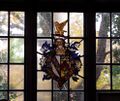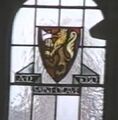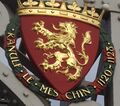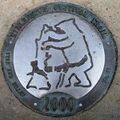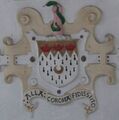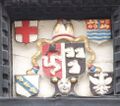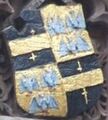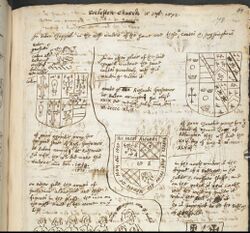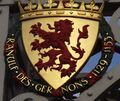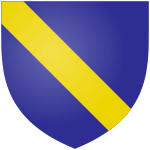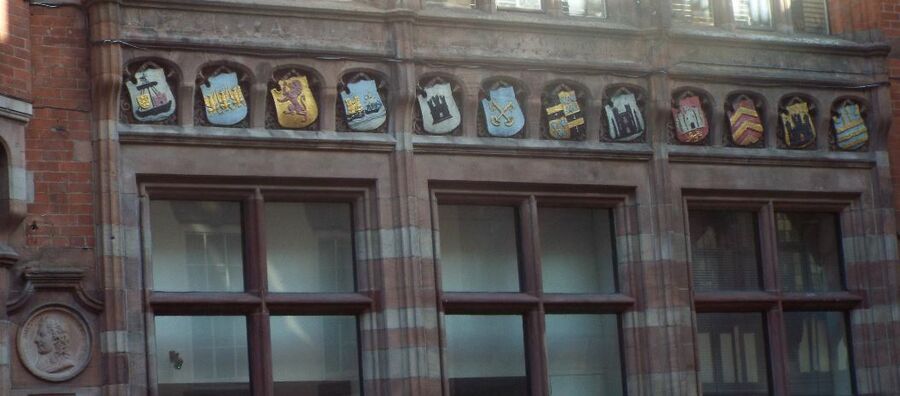Chester Heraldry Tour
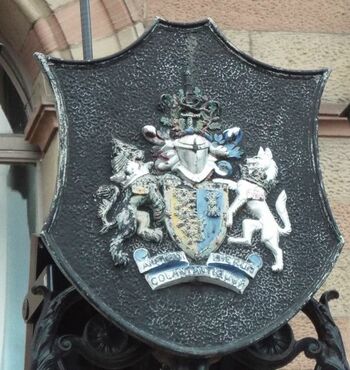
Arms in Chester
"Arms" are dotted all over Chester and the local gentry seem at one time to have quite obsessed with them, possibly as a status symbol for "noble" ancestry. Randle Holme made a reasonable living as a "Herald Painter" researching and depicting the coats of arms of the Cheshire gentry and several examples of his work can still be seen today. Ormerod's famous history of Cheshire is actually very much simply a list of notable ancestry and therefore was almost a guaranteed best seller when first published. A careful look above the door of the Cathedral reveals two almost identical coats of arms - one for the unfortunate Arthur Tudor and the other for his brother Henry VIII: the difference is tiny. Inside the Cathedral the cloister Stained Glass, although it dates from around 1930, contains a wealth of heraldic puns. Somewhat dubious Welsh coats of arms are plastered across the front of the Grosvenor Club near the Eastgate. Many pubs have a "sign" which while helping the illiterate find them also have armorial connections - in Castle Street there are (or were) at least three pubs associated with the Roman legionary eagle. The Suspension Bridge over the Dee has the arms of the Earls of Chester - not without some heraldic blunders. The Grosvenors got embroiled in a famous dispute over heraldry which led them to change their original coat of arms to the current wheatsheaf, and led to a curious incident involving a racehorse and even a Sherlock Holmes story. This article is a brief "tour" of "Heraldic Chester" and some of the often quite odd stories behind the "coats of arms" around the City. There is much more heraldry on show than discussed below, so this article may be updated from time to time.
"Coats of Arms"
In England, from the time of the Norman conquest, official documents had to be sealed. Beginning in the twelfth century, seals assumed a distinctly heraldic character; a number of seals dating from between 1135 and 1155 appear to show the adoption of heraldic devices in England. The earliest seals often show nothing other than a mounted figure of a armed warrior usually charging forward with a sword. The figure may be carrying a shield, but often only the inside of the shield is shown, possibly indicating that there is nothing special about the outside face of the shield. Thus, heraldry as developed in the High Middle Ages (c. 1000-1250), was based on earlier, "pre-heraldic" or "ante-heraldic", traditions of visual identification by means of seals, field signs, emblems used on coins, etc. In some cases, the adoption of a symbol on a coat of arms was the culmination of a gradual progression, whereby a family can be seen using a symbol in a quasi-heraldic manner prior to its adoption as part of a formal coat. An example of this are the Counts of Saint-Pol, who between 1083 and 1130 decorated their coins with wheat sheafs ("garbs") that are then found on the equestrian seal of Count Engueraud (1141–50) placed in the blank space surrounding the mounted knight, before appearing on the shield of count Anselm and his successors from 1162.
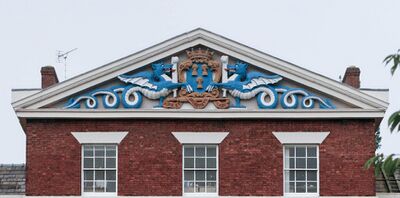
Heraldic designs came into general use among European nobility in the 12th century. Systematic, heritable heraldry had developed by the beginning of the 13th century. It is often claimed that the use of helmets with face guards during this period made it difficult to recognize one's commanders in the field when large armies gathered together for extended periods, necessitating the development of heraldry as a symbolic language, but there is little support for this view. For example, the earlier heraldic writers attributed the lions of England to William the Conqueror (as shown on the lodge in Grosvenor Park), but the earliest evidence of the association of lions with the English crown is a seal bearing two lions "passant", used by the future King John during the lifetime of his father, Henry II, who died in 1189. Many historic illustrations show "knights" wearing arms at very early times, when many of these arms were retrospectively assigned or "attributed" to the characters in question. The medieval mind did not seem to countenance a time when things had been different. For medieval people the world had always been much the same as it was then. So it is that medieval art invariably shows biblical characters in medieval dress, living in medieval houses and carrying on medieval trades. Some of the arms that these characters are associated with are clearly unlikely with one medoieval illustrator showing John the Baptist bearing arms which depict his own severed head.
Canting arms are heraldic bearings that represent the bearer's name (or, less often, some attribute or function) in a visual pun or rebus. While the history of the arms of the county of Cheshire is somewhat complicated. At some times it fratured a pair of seated wyverns holding ostrich feathers as is used (from circa 1840) on the 1829 building at the Asylum. In Norman French wyverns were called "wivres" (a variant of the French "guivre" - serpent), pronounced approximataly "Weaver" ("weever") and giving a typical heraldic rebus of the Cheshire river-name. The ostrich feather held by each dragon comes from the fact that the Earls of Chester (and Flintshire) was usually also Prince of Wales. At other times the wyverns have been replaced by lions, as in the "official" arms granted to the county in 1938.
Arms can themselves lead to the creation of myths. In many places there are stories which usually involve a competition between two parties for a patch of land by means of a race either on foot or accross a river. The race is to be decided by whoever first touches the goal, and the slower party manages to win by hacking off their own hand and throwing it at the target. Thenceforth they have a red hand in their coat of arms, such as the "Red Hand of Ulster". In fact, a red hand in a coat of arms is an option for baronets to add to their arms to indicate their rank. In Chester, city guides may often tell a story of the Grosvenors which involves the hacking off and throwing of a hand to claim land, but the myth originates by the "baronet" route.
A Gallery of Arms in Chester
1935 stained glass at Stanley Palace
Wrong arms on the Suspension Bridge
Arms used at the Bear and Billet
Snake and Hand at Leche House
On the front of Bishop Lloyd's House
Bats and daggers on the Grosvenor Club
Heraldry developed a rather formal code for what was allowed on arms. There are five traditional colours (red, blue, green, black and purple) and two "metals" (gold and silver) as well as two "furs", patterns which represent ermine and squirrel. A colour cannot be put on a colour or a metal on a metal - so a silver star on black is allowable, but not a red star on black. The main symbols on the arms (such as one or more lions) are called "charges". Initially, under the English tradition coats of arms were personal, but could be inherited. An heir might use the same arms while the owner was still alive but the arms would then have a mark of difference. Other descendants could modify the arms to show the family relation, but again would introduce a difference. If two people with arms married then the combined arms would be used, leading to some quite complex patterns. There are examples of all these features in the tour.
The Tour
Market Square

The "tour" starts at Chester Town Hall, which is frequently open to the public (but on occasion not). There are many "coats of arms" on display, both within and without. Several examples of the official Arms of Chester can be seen on the lamp-posts outside.
The arms of the city combine the wheatsheaves of some of the Earls of Chester and the royal lions of England on the two halves of the shield. One can take this as representing the aquisition of the Earldom of Chester by the crown in around 1237. There is actally some confusion about when the arms came into use. The supposed "regrant" of 1580 was by William Flower who describes himelf as the "Norroy King of Arms", However in the sketches for a map of Chester made by William Smith 1585 the arms shown are the three garbs of corn and sword design. Smith was also an antiquarian and "Rouge Dragon Pursuivant" at the College of Heralds/College of Arms, he should have been aware of a change to the arms being made just five years earlier. To compricate matters further Flower suggests that the version with the sword is not the original arms of the city and that this was more like the version he re-grants. Some writers suggest that a form of the later re-granted arms was in use in 1329 and are the oldest civic arms in the country. Whatever the truth, when the arms were formalised in 1580, Elizabethan warfare was moving from the longbow to the era of pike and musket and the military use of the shield in warefare was almost extinct.

The inside of the Town Hall features much of the civic heraldry that the Victorians were quite obsessed with. The main example being the Stained Glass on the staircase. The arms of most of the Earls is visible with the exception being Gherbod the Fleming, who may not have been an actual "Earl" and is the only one not carrying a shield. Hugh of Avranches has a shield wich is turned away from the viewer but in many other places around the city is depicted using a wolf as his symbol. The wolf also appears at the base of the window. Whether he used this in real-life is questionable as one can argue that "Hugh Lupus" ("Hugh the Wolf") was a pejorative nick-name given by the Welsh which refers either to his invasions of Wales or his gluttony. As noted above, heraldry on shields was not common in Hugh's time (there is very little in the Bayeux tapestry) and many of the arms depicted may have been "attributed" much later and would not be recognised by the supposed holders. In this case they might even be considered an insult. Richard of Avranches is depicted at the Town Hall with a red shield showing a wolf and decorated with crosses. This is again depicting arms which he is unlikely to have actually used, but does illustrate how early arms were personal, with sons often having related arms with differences.
It is worth inspecting the shields of Ranulf de Meschines and Ranulph De Gernon which are the next in the sequence at the Town Hall. These dispense with the wolf emblem and instead us a lion. Richard had died in the wreck of the White Ship and de Meschines was an indirect inheritor of his title. His correct coat of arms is a red lion on gold, and the Town Hall gets it right although it is wrong elsewhere, as will be encountered later in the tour. De Meschines was Viscount of Bayeux, which town frequently used a golden lion on red in its heraldry - this may reflect the Norman origins of the "English" lion, but also illustrates again how arms were personal. De Gernon (the son of de Meschines) has a silver lion on red and is often considered a "serial turncoat" due to changing sides several times during the war known as "The Anarchy". The term "Turncoat" dates from the 1550's and is believed to be related to changing one's allegiance by reference to a coat of arms displayed, although whether it involved turning an actual coat inside-out or simply wearing a different badge is unclear.

The next earl is Hugh de Kevelioc and he uses a completely different coat of arms to his father, marking the emergence of the wheatsheaves: in this case six of them. These "garbs" appear on many coats of arms associated with Cheshire and Chester and in many ways can be described as the county symbol. It is also found in the hallmark of the Chester mint, but also found in the arms of many towns and cities in the region. The origin of the "garbs" before de Kevelioc is uncertain and they may not even be wheat although they are typically gold they can also signify sheaves of rye, barley, oats or even flax. Ranulf de Blondeville reduced the number of garbs to three but kept the colours the same.
The Arms of Chester are clearly based on the arms of de Blondeville, and not those of the "last" Norman Earl John Canmore otherwise known as "John the Scot". Just why this is the case is not clear, although it may be that de Blondeville was the most well-liked of the Earls and had the most elegant and distinctive arms. It is also possible that there was a wish to distance the Earldom from the rather complex transfer of rights from the Earls of Chester to the Crown. Some writers have suggested that there is a "nod" to John the Scot in the form of "helmet" used in the city arms, which faces straight-on in the manner of Scottish heraldry rather than being slighly turned as in English heraldry. However the helm is one of the more variable bits of the city arms and different versions of it have quite a range of visor types - with the one on the Town Hall itself (above the main doors) being a barred helm which denotes a noble rank much higher than the steel tournament helm which is normally used for Scottish clan chiefs and in England esquires and gentlemen, and also generally used for burghal arms.
Inspection of the city arms also reveals the presence of the ostrich feathers of the Prince of Wales, although strictly they are those of the heir apparent. They are partly disguised by being in the "mantling" - the "streamers" above the shield. They also appear in the arms of the County Palatine from 1531. Traditionally, after the royal aquisition of the county, the Prince of Wales was made Earl of Chester and thus the effective ruler of the Palatinate, which was not part of England and did not fall under English law, but was held as the personal fief of the monarch. The border of acorns on the present arms (the ones on the lamp-posts) were added as rural districts became part of the City: these included Hoole in 1954. In 1975 two oak branches were added to the crest for the two rural districts and the two castles were added to the supporters for heraldic difference. The castles represent the Cheshire Castles along the River Dee.
In heraldry, a "mount" (also mountain, hill, hillock) is a representation of a hill or mountain as a curved terrace in base. In the Chester arms the mount appears as a compartment upon which the "supporters" stand. If the compartment is mentioned in the grant of arms it forms part of the grant and is an integral part of the arms e.g. the current royal arms of the United Kingdom are required to have a compartment with plant badges. If no compartment is specified in the blazon then whether to draw one is at the discretion of the artist.
The supporters on the city arms are a lion and a wolf. Supporters were at one time only generally granted to corporations which have a royal charter. Chester has had several Charters including a notable one by Henry VII. Older writers trace origins of supporters to their usages in tournaments, where the shields of the combatants were exposed for inspection, and guarded by their servants or pages disguised in fanciful attire. The lion and wolf on the official grant of the arms are "rampant" (in profile) whereas those on the Town Hall are "guardant" (looking outward). The wolf is that of Hugh of Avranches whereas the lion is presumably a royal one.
The remaining feature specified in the grant is "a sword sheathed erect girt with a belt thorough gilt situated above the torce distinguished with gold red and azure" This forms the "crest". The crest is said to represent the Chester City sword entwined with two oak branches. The branches represent the former Chester and Tarvin Rural Districts which were combined in 1974 to form the present City of Chester. The sword is part of the mayor's regalia.
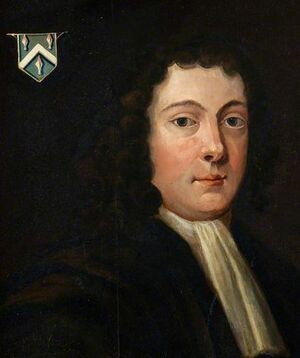
The former Co-op Bank building just across Northgate Street from the Town Hall and next to the Abbey Gateway Numbers 54 and 56 have shopfronts of c1900 with wood frames, leaded glazing above the transom bears the heraldic City Arms of Durham, Salisbury, Newcastle, London, Chester, Carlisle and York. The stained glass in the leaded glazing presents something of a puzzle: this particular feature of a shopfront was characteristic of Dunn & Co, the most recognisable chain of men’s hatters throughout the first three-quarters of the 20th century. It was probably in the 1920s that Dunn’s developed a particularly distinctive form of shopfront which endured as the house style for many years. This had a mock-timber-framed surround, including open spandrels filled with leaded glass. Across the top of the doors and display windows, a band of transom lights was filled with stained glass, depicting the coats of arms of major British cities against a textured emerald green glass ground. When an old shop front was removed from a G A Dunn & Co shop the stained glass panels depicting the various Coats of Arms were typically returned to the Estates Department for further use. They initially had a supplier who made them at a reasonable price but in later years the price became so expensive that the newer branches had Coats of Arms printed on a single sheet of glass. The stained glass in the Northgate Street windows is either a very late example of Dunn & Co or (more likely given the low quality) someone else trying to imitate their house style.
Pub Signs
The naming of inns and pubs became common by the 12th century. With pub names came pub signs – as the majority of the population could not read or write. In 1393, King Richard II (reigned 1377-1399) passed an Act making it compulsory for pubs and inns to have a sign (his own emblem the "White Hart" in London) in order to identify them to the official Ale Taster. The ‘Red Lion’ is probably the most common name for a pub and some state thst it originates from the time of James I and VI of Scotland who came to the throne in 1603. James ordered that the heraldic red lion of Scotland be displayed on all buildings of importance – including pubs. The Red Lion in Chester claims to date back to "around 1600" (they also claim their "Tudor front" dates from then). An alternative explanation is that the lion was part of the coat of arms of John of Gaunt, uncle of Richard II, who became king at the age of 10. When Richard suppressed the Peasants’ Revolt in 1381 many pubs showed their support for John of Gaunt by displaying his lion rampant.
Many other signs have royal links: for instance, most "White Lion" inns date from the time of Edward IV who used the "White Lion of Mortimer Badge" and the "White Boar" was the emblem of Richard III (often repainted blue after his death). The falcon was first used by Edward III of the House of Plantagenet as his badge.
Many pubs displayed a coat of arms as a sign and took a name based on this such as "The Shropshire Arrms", whose heraldry is based on that of Shrewsbury which contains the heads of three leopards. These are sometimes reffered to in Shrewssbury as "loggerheads", a reference to a joke portrait mentioned by Shakespeare which shows two "fools" and a third head in the form of a spoon with a face carved on the bowl. Art historians have suggested that images like these abounded in early-modern England and were intended as "trick pictures", visual gags which could be pinned up in pubs or used as inn signs. Such a picture is referred to in Act 2 of Twelfth Night, where Feste the Jester, greets Sir Andrew and Sir Toby with "Did you never see the picture of 'we three'?". Other versions of the image are known to have existed where the fools are replaced with two asses, which might explain Sir Toby’s reply to Feste: "Welcome, ass".
Crossed keys are the symbols of St Peter, the apostle who traditionally guards the gates of Heaven. The Cross Keys in Chester displays coats of arms of all its associated "tap-houses". The Bear and Billet may be derived from the emblem of Richard Neville, the Earl of Warwick, although there are other possible explanations. The "Oddfellows Arms" (there is an example in Frodsham Street) is derived from Oddfellows societies which began in London during the late 17th century, the name apparently derived from the odd assortment of trades the members would have, though it might also have been a joke. The first quarter is charged with an hourglass (symbolising the shortness of life and the need to prepare for old age), the second with two keys in saltire (symbolising the careful stewardship of members' funds), the third with a beehive symbolising collaborative effort leading to prosperity, and the fourth a lamb with a banner (often symbolising Christ but more generally humility, and possibly as a reference to Passover). The rose in the center may indicate that anything discussed is "sub rosa" i.e. confidential, but careful inspection shows that the rose is only part of an ensemble of plants which also include a leek, a thistle and a shamrock, respectively the symbols of Wales, Scotland and Ireland.
In Foregate Street can be found the immense carved arms which once adorned the "Green Dragon" hotel (the faded name can just be made out on the side of the building). The charges on the shield have dissappeared but the supporters can be seen to be a pair of dragons. The Green Dragon used to be a popular name for English pubs. The usual explanation for the Green Dragon name was that pub owners were showing support for the Earl of Pembroke and his family, the Herberts. The green dragon was not his arms, but it was his livery badge. Green Dragons may also have been subtly expressing support for King Charles II’s Catholic queen, Catherine of Braganza. She bore her family’s badge, the Green Wyvern of Portugal.
City Walls
In 1613 when the Phoenix Tower was in "ruinous condition" the Painters and Stationers first rented the tower at two shillings a year on the condition that they also put the tower in good order and maintained it. These two companies subsequently allowed others the use of the meeting place: the Barbers, Coopers, Butchers, Weavers, Joiners and Clothworkers. In that way the Phoenix tower became the headquarters of the city guilds. Randle Holme (who claimed to have founded the Freemasons in Chester) was paid 18 shillings for the carving and 6 shillings were paid to Edward Nixon towards putting it up. These payments were made January 10th 1693 - eighty years later than the date on the stone!

Randle had a less reputable side - he prepared items of heraldry and took fees for them without permission from the then Norroy king of arms, Sir William Dugdale. Dugdale took Randal to court, Holme lost the case and it was decided that all the offending boards should be removed, defaced or destroyed. Dugdale travelled north on at least three occasions to carry this out himself. Later Holme made peace with Dugdale and by 1675 was making funeral certificates for him. In 1678 he was appointed deputy herald for Chester, Lancashire and North Wales.
The Cathedral contains many heraldic representations in its Stained Glass. There is an interesting heraldic touch over the main door where ther are two almost identical shields those of Prince Arthur and his younger brother, later to become Henry VIII. The only difference between the arms is the "label" of three points placed on the chief (or top) of one shield of arms indicating that the holder (Arthur) is the heir apparent. The Greene Monument in the Cathedral depicts Thomas Greene who was mayor of Chester in 1565 and died in 1602: the arms of the city appear on his monument in lions/garbs form rather than the garbs and sword.
Other examples of heraldry can be found at St Olave and St Mary on the Hill. One writer describes thos at St Mary thus:
- "in the north chapel are two altar tombs, one of which, commemorating Thomas Gamull, recorder of Chester in 1613, and Alice his wife, has recumbent effigies of both, and at the feet of the lady is a kneeling figure of their infant son, afterwards the loyal Sir Francis Gamull kt. (1664); there are also figures of three infant daughters holding skulls in their hands, and on the sides of the tomb are two shields of arms: the other altar tomb, to Philip Oldfield esq. of Bradwall, ob. 1616, bears a half-recumbent effigy in marble, with two daughters kneeling at the head, in the costume of the period; figures of his four sons, each bearing a shield of arms, support the upper slab, and on. the side of the tomb is a painted skeleton in a similar attitude to the effigy above: in the north aisle is a mural monument of considerable interest, ornamented with heraldic devices, to four members of the Holme family, local antiquaries and heralds of repute; the third, Randle, was the author of the heraldic work, “The Academy of Armory,” published 1688"
The "Academy of Armory" was intended to consist of four books, each focusing on different aspects of heraldry, but following the printing of the thirteenth chapter of the third book Holme was unable to print the rest of his work even though he had – as stated in his passage to the reader following the final chapter – completed the manuscript. This manuscript, along with three other copies of the book, is now held in the British Library. The book itself is intended to be a comprehensive guide to heraldry in the seventeenth century but there are numerous occasions when Holme diverges from his topic and occasionally fabricates associations with heraldic objects. These digressions, although irrelevant to the book provide an extremely useful insight into the manners, customs, clothing and everyday lives of people in seventeenth-century Cheshire and are invaluable to the study of mid seventeenth-century culture and society.
A very extensive set of Holme manuscripts exist in the British Library. These include notes made as the Holmes toured local churches, collecting material about family histories, and notes copied from the works of other antiquarians.
Canting arms may be defined as armorial bearings that make a visual reference to the bearer's name or some attribute or function in a visual pun or rebus. The term was derived from the Anglo-Norman "cant", meaning song or singing. French heralds used the term armes parlantes, literally meaning "speaking arms", as they would sound out the name of the armiger. There are example of the type in St Mary on the Hill, where the arms of Brereton comprise a briar and a tun, and the arms of the Gamuls contain gavels.
The Suspension Bridge over the River Dee was built in 1923 as a virtual copy of the Porthill Bridge in Shrewsbury. It bears the arms of the Norman Earls of Chester but manages to mix two of them up. The shields had become rather weather-beaten over the years, and were impressively restored by David Kynaston in 2012/13. Cast out of lead, broken and missing parts were repaired. The shield were fully repainted and finished in 23 1/2 carat gold leaf. The "silver" wolves heads were finished in palladium leaf. Palladium is a rare metal and the major sources include the impact sites of meteorites. Thus, the "silver" on the suspension bridge may well be of extra-terrestrial origin. Even before restoration the arms on the suspension bridge were "mixed-up" with those of Ranulf de Meschines and Ranulph De Gernon swapped around. While the "silver on red" arms are badly tarnished, it still seems fairly clear that this was not the "gold on red" it was restored to, and it is still in the wrong place anyway.
Gallery: The arms on the Suspension Bridge
Ranulf de Meschines should be red lion on gold
Ranulph De Gernon should be silver lion on red
One peculiarity of English law was the existence of clauses in a will whereby the person that died willed that the beneficiary should take the name and the Coat of Arms of the deceased as one of the conditions of inheriting his estate. The Probate Court then dealt with the matter and required the person to comply with the deceased wishes as a matter of interpreting and carrying out the deceased’s will. The change of names and Coat of Arms had to be registered with the College of Arms because the court had to have official proof of the change. There was also a tax on the use of arms, but this was purely a financial matter and was levied on Coats of Arms whether registered at the College of Arms or borne of a man’s own free will. This tax was not abolished until 1945.
Eastgate and Watergate
The Eastgate carries the coats of arms of the English Royalty and the three garbs of Ranulf de Blondeville on the supports for the clock. These are the two sets of arms which are combined in the Arms of Chester, but on the clock they are displayed separeately. Below this on the bridge itself the arms differ on the two sides. The outer arms are the single garb of the Grosvenors as Barons and the inner arms are the three garbs and sword which are the arms of the county of Cheshire, although Hemingway describes these as the arms of the city. The sword and shield arms is the same as that known to have been used as the city arms of Chester at times, including prior to 1560. The arms of the County arms were officially granted only on May 3, 1938, and so post-date the gate which was constructed in 1768-9.
The arms of the Grosvenors are interesting because they were once the subject of a major dispute. In the heraldic case of Scrope v. Grosvenor (1389), Grosvenor maintained his ancestor, Gilbert, had come to England with William the Conqueror and had always had a blue coat of arms with a diagonal gold stripe. The case was brought before a military court and presided over by the constable of England - and the first sitting of the Court of Chivalry in the which decided the Scrope/Grosvenor Armorial Bearings was held at St Johns Church, Chester. Several hundred witnesses were heard and these included John of Gaunt, King of Castile and Duke of Lancaster, Geoffrey Chaucer and a then largely unknown Welshman called Owain Glyndŵr. The witnesses for Grosvenor stated that:
- ..it was generally reputed in the counties bordering on North Wales that his ancestors had borne the arms azure a bend or from the time of Sir Gilbert de Grosvenor a follower of Hugh Lupus Earl of Chester who was nephew to the Conqueror and that the said arms were to be seen in windows and on tombstones in several churches of Cheshire
The Abbot of the Cistercian Abbey Vale Royal spoke still more positively to the pedigree and arms of Grosvenor saying expressly:
- ..that he has it from chronicles and ancient writings in his monastery that Sir Robert Grosvenor descended in direct line from Gilbert le Grosvenor who in the train of his uncle Hugh Lupus came over with the Conqueror armed in the said arms which he used to the time of his death
No one seems to have considered in 1389 that there was no evidence whatsoever that coats of arms had been in use at the time of the Norman invasion, or that even the concept of an inheritable coat of arms did not exist in 1066. There was even a third claimant whose case was based on the "fact" that his ancestors had borne the same arms since the time of King Arthur.
In 1389 the case was finally decided in Scrope’s favor - but Grosvenor was allowed to continue bearing the "Bend Or" arms within a silver border. Neither party was happy with the decision, and in 1390 Richard II who had a minor obsession with chivalry evidently decided these shields were too similar for unrelated families in the same country to bear. Grosvenor switched to the blue shield with the golden sheaf of corn. The name "Bend Or" would resurface as the name of a racehorse, owned by the Gosvenors who won the 1880 Epsom Derby. A challenge was then lodged by the owners of Robert the Devil against Bend Or's Derby win on the grounds of him being entered under the wrong description. It was suggested that two foals had been mixed up and that it was the horse registered as Tadcaster that won the Derby. Recent research which compared DNA of Bend Or to that of Tadcaster relatives suggested the two had indeed been switched as foals. The "swap" may even have formed the basis for the Sherlock Holmes story "Silver Blaze". Some state that the "Bendor Range" is also named after the horse but it could also be a Gaelic-French hybrid - ben d'or - "mountain of gold" (note Welsh: Pen d'awr means the same thing). The range's western flank is the site of a series of now-semi-abandoned mining towns. One of these, Bralorne, is among the deepest mines in Canada and in its heyday was the third-richest gold mine in the world.
The Grosvenor Hotel, almost next to the Eastgate has the arms of the Duke of Westminster on the corner of it, featuring a pair of garbs and two portcullises. The portcullis was once an emblem of the House of Beaufort, and the first Tudor king, Henry VII, who was of matrilineal Beaufort descent, adapted both the portcullis and the Tudor rose as the Tudor badge. Although the Palace of Westminster served as the official royal residence for both Henry VII and Henry VIII until 1530, the current use of the portcullis as a symbol of the Palace and of Parliament does not date from that time. Rather, the symbol was developed as part of Sir Charles Barry's plans for the rebuilt Palace after the original burned down on 16 October 1834. The symbol was first used in the Dukes arms by the first Duke of Westminster (3 May 1880 – 9 June 1885). However the City of Westminster had a portcullis in its arms since Tudor times. The portcullis only appeared on the "Threepenny bit" in 1953.
The frontage of the Grosvenor Club contains a large number of coats of arms. In the stone lintel over the doorway in the entrance bay is a carving of the portcullis from the Grosvenor coat of arms. Above the door is a three-storey canted oriel window carried on corbels; between the corbels are two more coats of arms - the three sheaves as used by Ranulf de Blondeville which later became an emblem of Cheshire generally, and, the Arms of Chester city arms which combine the Royal arms of England - a red shield with three gold lions - and those of the earldom. Centrally between the middle and top-storey windows is the Grosvenors coat of arms. The most spectacular set of arms are those of historic counties of Wales in a strip above the ground floor windows. These are Glamorgan, Carmarthenshire, Pembrokeshire, Cardiganshire, Brecknockshire, Radnorshire, Montgomeryshire, Denbighshire, Flintshire, Merionethshire, Caernarfonshire and Anglesey. Monmouthshire was at various times counted as an English county, although it is a member of the original 13. With a little effort it is possible to link each coat to one of the counties: the page on the Grosvenor Club attempts to decode them. Also on the frontage, near the ground, is the coat of arms of Owen Jones.
The arms on the frontage can be identified (left to right) as representing: Anglesey, Caernarfonshire, Montgomeryshire, Flintshire, Merionethshire, Denbighshire, Brecknockshire, Cardiganshire, Carmarthenshire, Glamorgan, Pembrokeshire and Radnorshire.
The former Martins Bank on the corner of St Werburgh Street has the bank's heraldic arms on it in two places. Tradition has it that Thomas Gresham, whose family crest included a grasshopper, founded what was to become Martin's bank in 1563, although he is believed to have used the sign of the Grasshopper on a goldsmiths shop in Lombard Street. According to ancient legend, the founder of the family, Roger de Gresham, was a foundling abandoned as a new-born baby among long grass in Norfolk during the 13th century and found there by a woman whose attention was drawn to the child by a grasshopper. Although a beautiful story, it is more likely that the grasshopper is simply a canting heraldic crest playing on the sound "grassh-" and "Gresh-". The "Liver Bird" element comes from merger with the Bank of Liverpool in 1918 to form The Bank of Liverpool and Martin's Limited. The title was shortened to Martins Bank Limited (without an apostrophe) in 1928.
On the other side of St Werburgh Street the Nat West Bank bears the "arms" of the bank. The logo, designed in 1968, three interlocking cubes which symbolised “three separate banks coming together under the brand” – originally National Provincial Bank, Westminster Bank and District Bank. The first "skyscraper" in the city of London was initially known as the National Westminster Tower. Seen from above, the shape of the tower resembles that of the NatWest logo (when interpreded as three chevrons in a hexagonal arrangement).
Further along the street are more examples of the lion and wheatsheaves city arms. Some are very high up and easy to miss. On Lockwood's building on the corner of Bridge Street are the arms of both the Duke of Westminster and the Cavendish family. The same pair are also found together in the west window at St Johns. Lockwood built for the 1st Duke of Westminster, Hugh Grosvenor whose second wife was Katherine Cavendish the daughter of William Cavendish. The Cavendishes were founded by John Cavendish of Cavendish (c. 1346–1381).
St Peter at the High Cross contains an example of a heraldic funeral monument in what was once the vestry. As noted above, the family of Randle Holme found gainful employment in the organisation of funerals and the production of funerary hatchments or memorial boards. A funerary hatchment is a depiction, often within a black lozenge-shaped frame, generally on a black (sable) background, of a deceased's heraldic achievement, that is to say the escutcheon showing the arms, together with the crest and supporters of his family or person. The funerary hatchment was usually placed over the entrance door of the deceased's residence at the level of the second floor, and remained in situ for six to twelve months, after which it was removed to the parish church. The practice developed in the early 17th century from the custom of carrying a heraldic shield before the coffin of the deceased, then leaving it for display in the church. The example in the former vestry at St Peter shows the arms of two families: the Cowpers and the Thorpe/Thropp family. Both families played significant parts in the history of Chester. The Cowpers provided the Royalist mayor of Chester at the time of the Civil War. The Thorpe/Thropp family have a rather mysterious link to William Shakespeare, as Richard Thorpe/Thropp stationer, of Chester was a relative of the Thomas Thorpe who published Shakespeare's sonnets. As families married further additional arms would added as quarters and eighths. There are many more examples of hatchments and memorial boards at St Johns.
There is much to see at Leche House in Watergate Street, but of heraldic interest is the coat of arms present as a plaster moulding on the chimney above the fireplace. Simpson descibes it as follows:
- In the upper portion is a shield bearing the arms, and above, the crest of the Leche family of Carden, Cheshire, with a crescent on a crescent for difference; which in heraldic language are: Ermine, on a chief dancettee gules, three ducal coronets or, with a crescent for difference; that is to say, on a field of ermine is placed at the top a red band, the lower edge indented in a large and broad manner, on this three golden coronets, or crowns; in the centre of the field a crescent denoting that the arms are those of a second son. Crest: on a wreath a cubit arm proper, the hand grasping a snake vert.
While snakes are often symbols of treachery, but in this case the symbol is associated with medicine. John Leche, was surgeon (i.e. "leech") to King Edward III (13 November 1312 – 21 June 1377) who by patent (50 Edw. III.) was grantee of Castle Warin, and other lands. He appears to have continued as surgeon the Richard II
Ther is more heraldic symbolism on the frontage of Bishop Lloyd's House. This is quite complex: one of the panels seems to be dedicated to the arms of James I the other to the Lloyd family.
In 1935 an elaborate stained glass window was installed on the second floor at Stanley Palace. It depicts the Coat of Arms of James Stanley the 7th Earl of Derby, and quartered on it, the Arms of his wife, Charlotte de la Tremoille. Her father was Claude de La Trémoille. Her maternal grandparents were William I, Prince of Orange, and Charlotte de Bourbon. The French motto is that of Knights of the Garter honi soit qui mal y ponse, 'Evil he who thinks ill of it'. 'The Eagle & Child,' which forms part of this Coat of Arms is associated with the unlikely legend that one member of the family was a foundling who was deposited by an eagle. The Stanley coat of arms contains three stags heads. This is an allusion to the fact that the Stanleys were at one time hereditary keepers of the Earl of Chester's hunting forests on the Wirral.
James Stanley supported the king in the Civil War and took part in Prince Rupert's successful campaign in the north. He was with Charles II at the Battle of Worcester after which on 3 September 1651 he accompanied him to Boscobel House. While on his way north alone he was captured near Nantwich and was imprisoned at Chester Castle and tried by court-martial at Chester on 29 September. He was found guilty of treason under the terms of the Act of Parliament passed in the preceding month (which declared those who corresponded with Charles II guilty of treason), and he was condemned to death. His appeal to Parliament for pardon, although supported by Oliver Cromwell, was rejected. He endeavoured to escape from Chester Castle but was recaptured by Captain Hector Schofield. He was taken to Bolton for his execution, because of his part in the Bolton Massacre. He was beheaded on 15 October 1651 at the market cross in Churchgate, Bolton, near the Man and Scythe Inn, owned at the time by the Earl of Derby's family.
